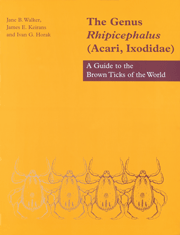Book contents
- Frontmatter
- Contents
- Acknowledgements
- 1 Introduction
- 2 Relationships of the ticks (Ixodida) and definition of the genus Rhipicephalus
- 3 Format for the accounts of individual species
- 4 Glossary
- 5 Rhipicephalus species names of the world
- 6 Rhipicephalus species occurring in the Afrotropical region
- 7 Accounts of individual species occurring in the Afrotropical region. pages 59 to 277
- Accounts of individual species occurring in the Afrotropical region. pages 278 to 490
- 8 Host/parasite list for the Afrotropical Rhipicephalus species
- 9 Rhipicephalus species occurring outside the Afrotropical region
- 10 Accounts of individual species occurring outside the Afrotropical region
- 11 Host/parasite list for the non-Afrotropical Rhipicephalus species
- 12 Species groups based on the immature stages
- 13 The transmission of tick-borne diseases of animals and humans by Rhipicephalus species
- Index
6 - Rhipicephalus species occurring in the Afrotropical region
Published online by Cambridge University Press: 05 November 2011
- Frontmatter
- Contents
- Acknowledgements
- 1 Introduction
- 2 Relationships of the ticks (Ixodida) and definition of the genus Rhipicephalus
- 3 Format for the accounts of individual species
- 4 Glossary
- 5 Rhipicephalus species names of the world
- 6 Rhipicephalus species occurring in the Afrotropical region
- 7 Accounts of individual species occurring in the Afrotropical region. pages 59 to 277
- Accounts of individual species occurring in the Afrotropical region. pages 278 to 490
- 8 Host/parasite list for the Afrotropical Rhipicephalus species
- 9 Rhipicephalus species occurring outside the Afrotropical region
- 10 Accounts of individual species occurring outside the Afrotropical region
- 11 Host/parasite list for the non-Afrotropical Rhipicephalus species
- 12 Species groups based on the immature stages
- 13 The transmission of tick-borne diseases of animals and humans by Rhipicephalus species
- Index
Summary
HISTORICAL REVIEW The first rhipicephalid to be recognized was the cosmopolitan species Rhipicephalus sanguineus, collected in France and described by Pierre Andre Latreille (1806). His description was brief in the extreme – ‘Sanguineus, punctatus, postice lineolis tribus impressis; dorso antico macula nulla thoracica, distincta.’ Translated from the Latin this means: ‘Blood red, punctate posteriorly with three impressed lines; no distinct thoracic spot anterodorsally’ (M.-L. Penrith, pers. comm., 1997). Latreille placed this tick in the genus Ixodes but Koch (1844) reclassified it as a member of his newly erected genus Rhipicephalus, and at the same time described three new species, R. capensis, R. senegalensis and R. simus. Nearly 30 years later A. Gerstäcker (1873), who studied various arthropods collected by Baron C.C. von der Decken during his travels in East Africa, described R. praetextatus and R. pulchellus. The latter, on account of the ornate scutal pattern of the adults, was originally regarded as a species of Dermacentor.
Towards the end of the 19 th century and early in this century research on ticks rapidly gathered momentum as these parasites became increasingly recognized as important vectors of various animal pathogens. In 1898 an American, C.P. Lounsbury, who had arrived in South Africa 3 years earlier to take up his appointment as Government Entomologist to the Department Department of Agriculture, Cape of Good Hope, turned his attention to ticks and tick-borne diseases. He soon established contact with two outstanding authorities in Europe, L.G. Neumann in Toulouse, France, and G.H.F. Nuttall in Cambridge, England. Neumann, who had already described R. compositus in 1877 and R. evertsi in 1899, based his descriptions of R. appendiculatus and R. nitens on Lounsbury's collections.
- Type
- Chapter
- Information
- The Genus Rhipicephalus (Acari, Ixodidae)A Guide to the Brown Ticks of the World, pp. 40 - 58Publisher: Cambridge University PressPrint publication year: 2000

